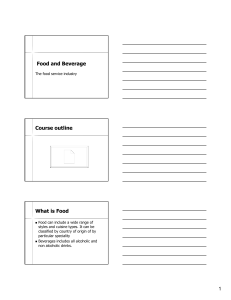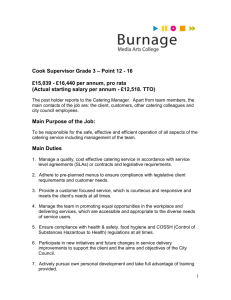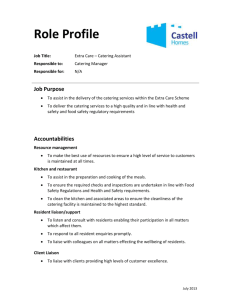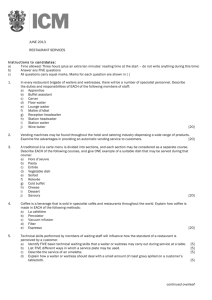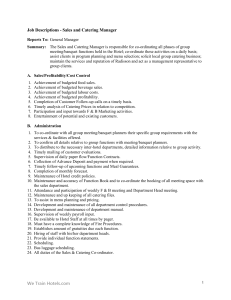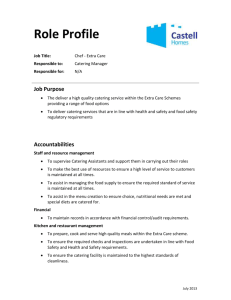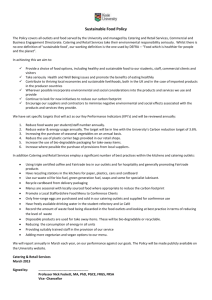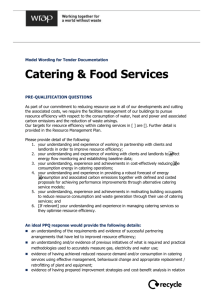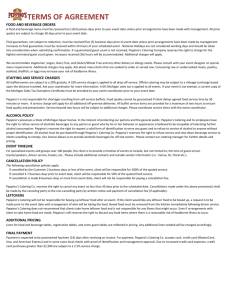Unit1 - E
advertisement
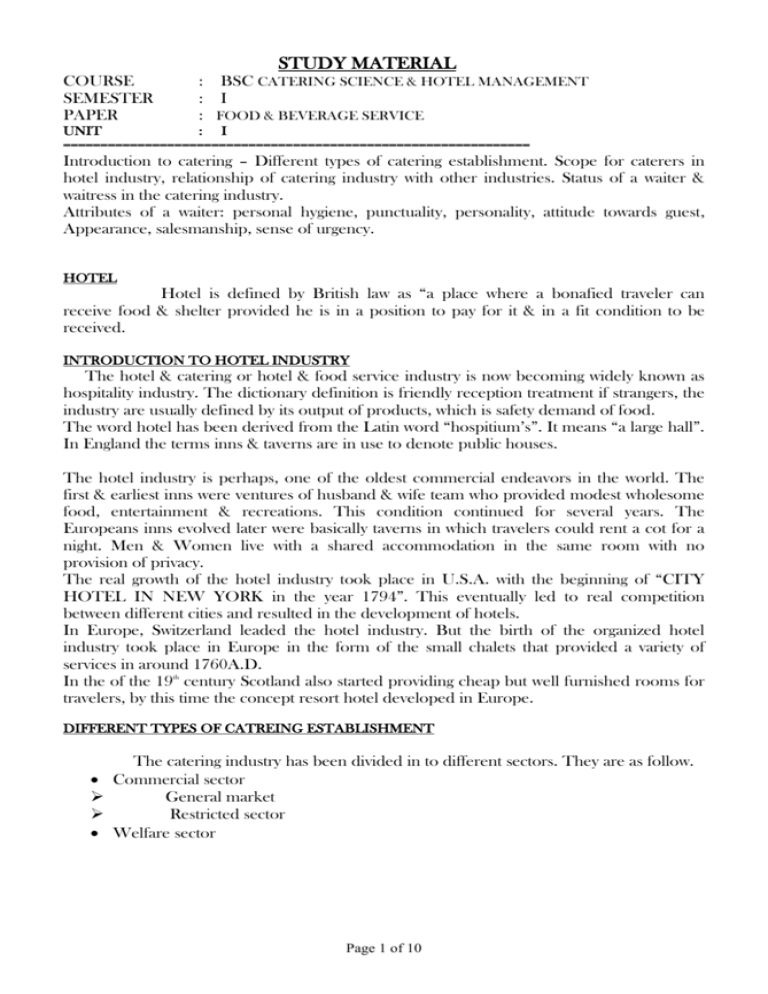
STUDY MATERIAL COURSE SEMESTER PAPER : BSC CATERING SCIENCE & HOTEL MANAGEMENT : I : FOOD & BEVERAGE SERVICE UNIT : I =============================================================== Introduction to catering – Different types of catering establishment. Scope for caterers in hotel industry, relationship of catering industry with other industries. Status of a waiter & waitress in the catering industry. Attributes of a waiter: personal hygiene, punctuality, personality, attitude towards guest, Appearance, salesmanship, sense of urgency. HOTEL Hotel is defined by British law as “a place where a bonafied traveler can receive food & shelter provided he is in a position to pay for it & in a fit condition to be received. INTRODUCTION TO HOTEL INDUSTRY The hotel & catering or hotel & food service industry is now becoming widely known as hospitality industry. The dictionary definition is friendly reception treatment if strangers, the industry are usually defined by its output of products, which is safety demand of food. The word hotel has been derived from the Latin word “hospitium’s”. It means “a large hall”. In England the terms inns & taverns are in use to denote public houses. The hotel industry is perhaps, one of the oldest commercial endeavors in the world. The first & earliest inns were ventures of husband & wife team who provided modest wholesome food, entertainment & recreations. This condition continued for several years. The Europeans inns evolved later were basically taverns in which travelers could rent a cot for a night. Men & Women live with a shared accommodation in the same room with no provision of privacy. The real growth of the hotel industry took place in U.S.A. with the beginning of “CITY HOTEL IN NEW YORK in the year 1794”. This eventually led to real competition between different cities and resulted in the development of hotels. In Europe, Switzerland leaded the hotel industry. But the birth of the organized hotel industry took place in Europe in the form of the small chalets that provided a variety of services in around 1760A.D. In the of the 19th century Scotland also started providing cheap but well furnished rooms for travelers, by this time the concept resort hotel developed in Europe. DIFFERENT TYPES OF CATREING ESTABLISHMENT The catering industry has been divided in to different sectors. They are as follow. Commercial sector General market Restricted sector Welfare sector Page 1 of 10 . SECTORS IN CATERING INDUSTRY ↓ ▼ -------------------------------------------------------------------▼ ▼ PROFIT ORIENTED/COMMERCIAL WELFARE MARKET │ MARKET │ ----------------------------------------------------- │ │ ▼ ▼ ▼ GENERAL MARKET RESTRICTED MARKET │ ---------------------------------------│ ▼ ▼ FAST FOOD TRANSPORT INSTITUTIONAL HOTELS PRIVATE WELFARE CATERING RESTAURANTS CLUBS COLLEGE TAKEAWAYS INDUSTRIAL UNIVERSITY PUBS/BARS SCHOOLS PPOPULAR CATERING BANQUETING/CONFERENCE AIR FORCES MOTOR WAY SERVICE PRISONS OUT DOOR CATERING VENDING MACHINE SNACK BAR/ MILK BARS ▼ COMMERCIAL SECTOR: It is a sector where the food & beverage service is open to the public & the society Peoples. These public sectors are run under a profit motive. The commercial sectors are under taken both by the public as well as private sectors. In the commercial sector we can see two different markets. They are as follows General Market Restricted Market GENERAL MARKET: General market is open to the public. The customers have there own choice in receiving the food & beverage service. These General markets are all profit-oriented markets. RESTRICED MARKETS: In the restricted market the customer may not have more choice. The market is not open to all; there is a restriction in the usage of such markets. Its main motive is to earn profit by rendering the service to a limited number of customers. For example the transport catering has a number of characteristics not commonly associated with other food & beverage outlets. Usually in transport catering the food service involves for a large number of customers for a specific period of time. So the transport catering would serve the food & beverage only for the customers who travel. HOTEL: Page 2 of 10 Hotel is the place where food & drinks are provided in spite he is in a position to pay for it & he should be in a fit condition to receive it. Some examples for hotel are as follows Commercial Hotel Motels Boatels Suburban Hotel Casino Hotel Conference Hotel FAST FOODS: Fast foods are a combination of popular catering & take aways. These outlets provide food & beverage in highly specialized environment characterized by high investment, high labour cost, & high customer turn over. In these places the food is pre prepared & kept. As soon as the customer orders the food is prepared & it is served faster. RESTAURANTS: Restaurants are the food & beverage outlets where food & drink is provided generally at a high price with high levels of service. This may be a part of a Hotel or of a private ownership. They provide seating arrangements & it also provides a personalized service. Restaurants are of two types. a) Specialty Restaurants: The atmosphere is more sophisticated & caters to people who can eat leisurely & the entire décor & atmosphere is glazed to a particular region or country’s cuisine. Examples: Indian Restaurants Chinese Restaurants Italian Restaurants Thai Restaurants b) Multi cuisine Restaurant: These restaurants offers dishes more than one cuisine. This offers a good selection. In India the usual multi mixes of Indian, Chinese, & Continental cuisines are being included. TAKE AWAYS: These take away outlets have developed from the fish & chips concept. Here the customer orders & then he is being served from a single point, at counters. The customer can even take away the food. Some examples of take away are as follows. o Sandwich bars o Kentucky fried chicken outlets PUBS / BARS: These outlets provide snacks & drink to the customer. They provide snacks like chicken tikka, fried chicken, vegetable pakoras, omelets, scrambled eggs etc.. They also provide alcoholic beverage & non-alcoholic beverages to the customer. The food & beverage are served in a highly specialized environment with music in the background. Special themes would be a added advantages to these outlets. POPULAR CATERING: They consist of a varied group of establishments, which mainly offers food & drink at low or medium price. The range of food item offered mainly being of the convenience food type, but times extending to fresh food items. The levels of service will be limited. Page 3 of 10 E.g. Cafes, pizzas, steak house etc. BANQUETING / CONFERENCES: They provide food & drink to people on a large scale, usually prebooked by the customer. These include the service of food & beverage to social functions such as wedding, cocktail dinners, business functions like conference & meeting. In large hotels the food & beverage will be served inside the banquet halls or inside the conference halls. MOTORWAY SERVICE STATIONS: These outlets provide food for motorway travelers and are often located in isolated places. They provide fuel and other accessories to the vehicles also. OUTDOORS CATERING: These are developed through need to provide services at special events. These “Off Premises” catering of food & beverage are always away from the home base & suppliers. The term ODC misleading as little as catering actually takes place outside. MILK BAR / SNACK BAR: Here non-alcoholic beverages & snacks are served with customer service or limited table service. The décor is relatively less expensive. VENDING MACHINE: These are small outlets of business; automate with coins, tokens or money card. It is semi-automated with single point service according to the denominated values it operates. The advantages of automotives machines are 24 hrs service Low cost Increase in productivity Food cost control Economy of labour Fresh beverage Variety Reduced wastage Easy to maintain TRANSPORT CATERING: Railway Catering Flight Catering Ship Catering a) RAILWAY CATERING: Provision of food & drink to travelers in many forms, form fast food, snack bar in the station concourse to meals served in the first class dining-car of an intercity train, or a gourmet meal as on the oriental express. Service is done in disposable containers. b) FLIGHT CATERING: This is of two types o Air –Line Catering for first class passengers Page 4 of 10 o Charter airlines In flight catering, prepared tray of food is passed to travelers & disposables knives, forks, spoons, cups & glasses any be used. But this may extend to the service from gueridon trolleys for first- class passengers. c) SHIP CATERING: Marine catering provides food & beverage to a large cruise liners & passenger ships. On the cruise liners the standard of service, facilities & food would be high because they are an important sales feature in business. The service provided in small ships & ferry will be of fast food type. PRIVATE WELFARE HOUSES: A private welfare house provides food & beverages for some particular customers who stay in the private welfare house. The customer would be like MD of some company or might be executives. CLUBS: Clubs are establishment that offer food & drink & at times accommodation to the members of the club and bonfide guests. Different types of clubs include working men’s club, club of the political parties; social clubs, sports club etc. Only the member of the club can use facilities. INDUSTRIAL CATERING: These catering establishments provide food & drink only to the workers who work in that particular company or industry. This industrial catering service would provide the required service at a minimum cost. WELFARE SECTOR: The welfare catering is the catering service, which is not dependent on the profit. Its main motive is to serve the people. This type of catering service is done in the college, universities, schools, hospitals etc. In the welfare sector the customer have no choice. This denotes the provision of food & drink to the people for social needs. An authority will determine the entire catering service. INSTITUTIONAL CATERING: o Schools o Colleges/ Universities SCHOOLS: These provided nutritious diet for students either for breakeven/ meager profit. COLLEGES/ UNIVERSITIES: The canteens, which are open in educational institutions, function with a meager profit/ breakeven HOSPITALS: Here the diet food is prepared in wholesome for the patients who are admitted in the hospital. The food is served usually on a no profit no loss basis. PRISONS: Here the meals are provided only for the prisoners. It is not run on a profitoriented motive. Page 5 of 10 THE FORCES: The army, navy & the Air force provide meals to its staff member on a subsidy rate. SCOPE FOR CATERERS IN THE CATERING INDUSTRY. If you want to find out about the opportunities within the catering industry. There are number of people who will be happy to help you. In all sectors of the industry, how well you progress will to a large extent depend on you. Of course your technical skills are of great importance, and the more you can develop them the better, but you will be unlikely to work in isolation, so a lot of other attributes which relates to working with people will be just as important. All this can be summed up in one word “professionalism”. Your aim should be to become a good professional caterer. Career opportunities with in the catering industry can be divided in to four areas. They are as follows o Food Production o Food & Beverage Service o House Keeping o Front Office Food Production: The career opportunities are best in food production department is considered to be the best. The way in which food production staff is organized in a kitchen will depend on the type of operation. Progress with in the staff would depend upon the performance shown during the training period & the performance shown during on the job training. If you would like to join as Chef De Parties then you should train up with the technical skill as well as the basic knowledge about food production. If you perform well in your area then you will be promoted as a senior supervisor. It all depends on your technical skill & your attributes towards the work given to you. Food & Beverage Service: In a traditional hotel or restaurant, a trainee or commis waiter would assist a station waiter who is responsible for the food & beverage service in part of a restaurant. After a period spent as a station waiter you might be promoted as a headwaiter if you have excelled in your work area. As a supervisor in a restaurant you should have the full knowledge about all the aspect in the restaurant. Many supervisor have worked in their own way up through the company, having first gained experience in taking order, service of food & beverage, taking with the customer courteously, politely etc. House Keeping: The house keeping involves of job like up keeping cleanliness of the hotel, rooms & the surrounding of the hotel. A new entrant to this area of work might begin by doing some housekeeping & general cleaning duties. The next stage could be that of a floor housekeeper, who is responsible for one section in a particular floor. He should maintain the cleanliness of that particular area. The head housekeeper is responsible for the accommodation of the whole operation & may have an assistant head housekeeper. In the case of large hotel an executive housekeeper is appointed to look after the house keeping departments. There are number of positions held in the house keeping department like Page 6 of 10 executive housekeeper, assistant executive housekeeper, floor supervisor, public area supervisor etc. Front Office: The front office work will vary with the size of the operation. A trainee receptionist might begin by dealing with advance reservations & simple clerical tasks. This might be followed by duties at the reception desk itself, which may involve attending to customer need & dealing with cash & billing. The next stage could be that the shift leader, where responsibility is taken for a period of the day. A reception manager is responsible for the whole of the reception operation. In addition to these fairly clear-cut positions in the different areas of the catering industry- that of course may be in any sector of the industry there are other areas they are common to many industries. Personnel & training & sales & marketing are important aspects of the catering industry, which presents opportunities for suitably, qualified people with experience of the industry. Qualification: The catering industry places great emphasis on appropriate qualifications. These are obtainable by a number of methods such as full-time or part-time college courses & training. Scheme arranged by catering board, travel agency, hotel & others. ATTRIBUTES OF A WAITER OR WAITRESS: Any food service staff coming in contact with the customer is also a pert of the product. No matter how good the quality of the food, beverage, décor & equipment, poorly trained staff can destroy the customer’s potential satisfaction with the product. It is also true that well trained, smart & helpful staff can sometimes make up for aspects that are lacking else where in the operation. They should develop right habits & should possess right qualities, which include certain in born social graces that cannot be installed by training. The waiter is the prime person around whom the actual services of food & beverage are carried out. A food & beverage staff / waiter should mainly have some Mental attributes Physical attributes Personal attributes Social & welfare skills Communication skill Knowledge Manipulation skill 1.MENTAL ATTRIBUTES: a) Good Memory: Good memory can help to improve work performance brought about by being better organized because small but important details are not forgotten. Customer satisfaction can be increased by a waiter being able to put a name to a face because of having served him on a previous occasion. This Can be taken further by placing the customer at his preferred table & is his favorite seat & better skill, remembering his likes & dislikes regarding food & wine. b) Observation: Page 7 of 10 A waiter should observe and should be able to observe and able to classify customers. So being able to treat them in the way they should wish & to address them in the most appropriate manner. 2. Physical Qualities: All the time a waiter is on duty he is continuously under observation by a customer who is watching how he holds himself, & how quickly he moves around a) Grooming & Personal Hygiene: This is of almost importance because waiters work near the guest & are always handling food materials. The men & women should be having trimmed nails & clean hands. The points to be noted are. 1) Wash hands after handling raw foods, using W.C, sneezing, coughing, using a handkerchief, & before starting any food preparation. 2) Men should be properly shaved. Females should either have a short haircut or the hair should be tied properly. 3) Uniform should neat & clean. 4) Uniform worth should be physically fit to accomplish his work that involves long duration of standing, walking around. 3. Personal Attributes: a) Honesty: A waiter should possess this quality in dealing with both the customer and the management. The staff working should also be very honest with the executives & staffs working with him. Then there will be a atmosphere of work which would encourage efficiency & good spirit amongst the food & beverage service operators. b) Loyalty: The staff obligations & loyalty are firstly to the establishment in which they are employed & its management & the customer. c) Punctuality: This particularly refers to the punctuality towards the duty. The staff should report at correct time since the whole work done in a restaurant is manual & presence of workers in proper time is necessary. Once a waiter is late for duty. He shows lack of interest & lack of respect towards the management. d) Conduct: The waiter’s conduct should be impeccable all times, especially in front of customers. The rules & regulations or an establishment must be followed, and respect shown to all senior members of staff. e) Personality: The staff must be tactful, courteous, good humored & of an even temper. They must convenes with the customer in a pleasing & well spoken manner & the ability to smile at the right times pays dividends with these attributes the staff will help the management by becoming good sales people. 4. Social & Technical Skill: a) Attitude to customers: The correct approach to the customer is of at most importance. The staff must not be servile, but anticipate the customer’s needs & wishes. A careful watch would be kept on customer’s at all times during the service with out sharing. b) Sales Ability: Page 8 of 10 The waiter should have the fair ability to sell the product. Since he is the front line sales personnel of the organization, this can promote by recommending dishes (suggestive selling) & giving the right service. c) Sense Of Urgency: A busy executive would need a quick service for a business luncheon & the waiter must serve the main course immediately the first course is cleared. The same executive may be patronized the restaurant for dinner but will expect a more released service & would wish to make it a social rather than a business occasion. 5. Communicative Skill: He should have a good command over English language & should present himself well. Knowledge of local language & foreign language is always desirable. An important part of the social skill required of a waiter is that of being confident when he talks to important people who are patronizing the restaurant. 6. Knowledge: The knowledge required by a waiter is of the basic methods of cooking & the kinds of food cooked by each method, of those special commodities, which are seasonal in use & a basic knowledge of nutritional value of a range of food. If specialization as a sommelier, then he should know which food can accompany which type of drink. The waiter should also have the full knowledge of food being served to the customer. 7. Manipulative Skill: The waiter should know the basic requirement of service, use of equipment. This must be observed & practiced as an integral part. Manipulative skills even involve basic judgment & calculations to conduct the entire service. STATUS OF WAITER IN CATERING Today in many food & beverage outlets do not provide any waiting service at all, and the take away restaurants also eliminate the waiter. In the social & economical conditions of to day, more & more people eat away from home. Thus there can be few who do not have a general nation of the work of the waiter & waiters and its board purpose. The waiter not only serves food, but does, play an important part as, in effect, a salesman of food one who assists materially in merchandising and its accompanying service. Waiter & Waitress are sales staff in a firm, just as the chef is its manufacturer, turning raw materials in to palatable dishes. A successful hotel, restaurant or café is one which guests are anxious to visit again, a place where they feel as comfortable as their own homes. This pleasant atmosphere is produced by courteous, good well cooked food; advice in selecting from the available dishes; a knowledge of how they are prepared; given by staffs working in the restaurant. By this way both the buyer & seller are satisfied & good of the business is also increased. The partner: A successful catering establishment depends on three partners – management, cooks & the sales staff. They have different parts to play, but they belong to a united team. All must have an interest in work, feeling of pride in the concern & a sense of loyalty towards it with this attitude of mind, there is no drudgery in any of the work. Much of the catering & hotels success, therefore depend on the skills, interest & personal qualities a h individual staff has. The efficiency of a waiter reacts upon the success Page 9 of 10 of the hotel restaurant or other catering establishment for which he is working. His work, his attitude to those above Advancement: Nearly all post of head waiter, maitre d hotel or restaurant manager, are obtained by those who have spent years of service in waiting, and have learned, by training & experience, the best ways to do the work which they organize & direct. This applies also to many of the most successful owners who run the catering establishment. Conditions Of Work: As in all industries, government acts controlling the hours, wages, & conditions exist in the catering industry. Wages boards have been formed, so that the minimum rates pay (and other conditions of service) may be regulated for the various sections of the industry. The following statements should be taken as an indication of the conditions that apply in industry generally. The waiter is in favored position of spending the greater part of his time in the public rooms (restaurants), which are clean, comfortable, lighted & carpeted. Food has to be brought from the kitchen to the restaurant. Where there are service elevators, or the kitchen is on the same floor as the restaurant, service can be straightforward with out any strain to the staff, many kitchen the food has to be carried from upstairs to down stairs or from down to up according to the kitchen lay out. The waiter is nearly always on his feet, for he has to stand or walk about for many hours daily. The hours he will work vary according to the establishment. In a hotel that is open from early morning until late at night, the staff must be on duty (probably shifts) at all the times necessary to prepare for & serve the visitors. The working hour normally for a room service & coffee shop staffs are Morning shift 7.00am to 4.00pm Evening shift 3.00pm to 12.00am Night shift 10.00pm to 7.00am The working hour for the bar staff are as follows Break shift 11.00am to 3.00pm 7.00pm to 11.00pm Straight shift 2.00pm to 11.00pm The working hour for the restaurant staffs Break shift 11.00am to 3.00pm 7.00pm to 12.00pms ===================================================== Page 10 of 10

